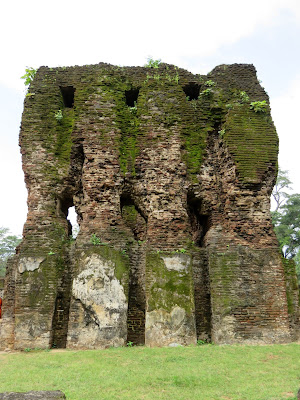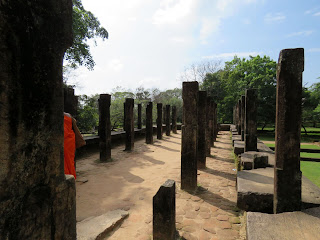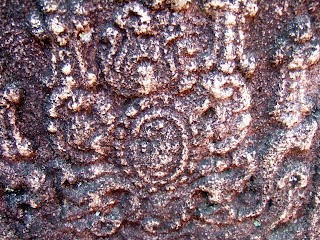
The well preserved and compact world heritage site of Polonnaruwa ruins located just 200 km from its national capital of Colombo, was an ancient kingdom of Sinhalese monarchs in medieval period for 800 years. The city began to establish into a capital in 10th century by King Vijayabahu I (1055-1119)when its Anuradhapura Kingdom was politically in instability. The nation was facing civil wars, power struggles and also series of attacks from South Indian. Ruins of Polonnaruwa spread over an extensive area of about 5km from north to south , with clusters of ancient structures and monuments built by King Vijayabahu I and King Parakramabahu I (1123-1186) and subsequently repaired and restored by King Nissankamalla. The remains of Polonnaruwa reflect the old grandeur and glory of an ancient Kingdom.


The seven storey Royal Palace that King Vijayabahu I built for himself in 11th century stands at the heart of the city. The huge central edifice was constructed entirely with bricks and could be entered from a pillared hall from its east entrance. To its left are flight of steps that lead to the upper floors. There is a gallery containing more than 40 chambers or rooms around the hall and central edifice.


The seven storey royal palace where the king lived was a center of power.


The imposing structure are the remnants of a Royal Palace.



























Standing opposite the Royal Palace is The Audience Hall built by King Parakramabahu I in 12th century. The hall was built on a solid rock with three layers. Border of first layer was carved with elephants, second layer with lions and the third floor was carved with Wamana dwarfs. Figurines are all in different postures. The 4 rows of pillars with 12 units in each row on the top of platform are richly ornamented.

This was the place where King addressed his people or listened to their complaints.


The Hall was embellished with lion portals, graceful moonstone and pillars.













The floral design that were carved on the stone pillar.





The beautiful moonstone.


The lion portal




Side views of its layered platform.





The elephants and lion carvings at the sides of the bottom platforms.



An old well that was found near the Audience Hall.



The entire Royal citadel was surrounded by thick brick walls.



An awesome royal bath Kumara Pokuna locating short distance away from the audience hall was one of the interesting monuments found within The ruins of Royal Citadel.










Structures nearby the bath was also accomplished with moonstone and lively lions carvings.




A Fabulous old tree !

No comments:
Post a Comment